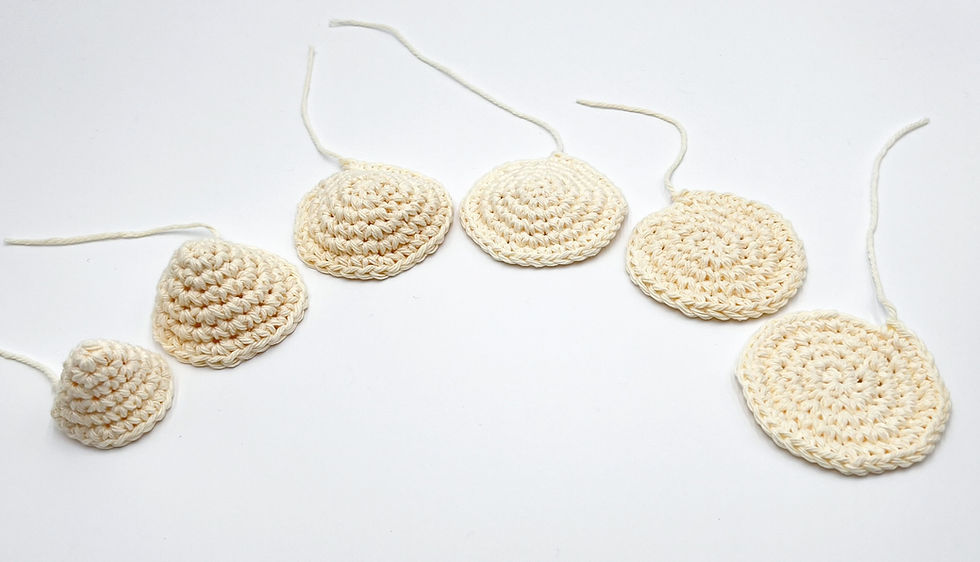The Increase Factor - in the Round
- Rebekah Cardenas

- Aug 2, 2024
- 4 min read
Updated: Aug 18, 2024
Crocheting in the round involves a bit of math and how we do that math determines the shape of our work.

As in all my tutorial posts, I have linked videos and/or articles to explain key concepts. If you're unfamiliar with any terminology in my posts, please click the links and utilize my resources to help get you up to speed. If you need something else explained, please contact me for more help - I am very responsive!
One of the most common things to crochet in the round is a flat circle. To make a flat circle, we begin with a magic circle or adjustable loop and crochet our first round into the center. To "grow" our circle, we must put more stitches into each new round than the one before (otherwise we're just making a tube).

Many amigurumi crochet patterns involve crocheting in the round, usually in spiral rounds, and increasing rounds by a factor of 6 (most common) or sometimes 5, 7, or 8. What this means, is that each new round has X more stitches than the one before - X being the factor of increases.
The increase factor determines the shape of your work. Here is an image for your reference:

These shapes plainly show how math affects the shape of your work. They were made with the same number of stitches in the first round as their factor indicates, and when the rounds are increased by:
3 - produces a sharp or pointy cone shape
4 - produces a slightly rounded cone shape
5 - produces a bowl or dome shape
6 - produces a curved shape (perfect for spheres)
7 - produces an almost flat circle
8 - produces a flat circle (perfect for Granny squares)
Common shapes and their increase factors:
Cone = increase by 3
Sphere = increase by 6
Flat 2D circle = increase by 8

A rule for these 3 common shapes: each round must have exactly X more stitches than the one before. Meaning, your increases must be symmetrical. If you deviate from the increase factor (example: you increase by 3 in one round then 6 for the next), your work will take on an asymmetric shape. Additionally, beginning with 3 stitches in the first round, and only increasing by 1 for each round after, produces an even sharper cone than the image above. The fewer the increases, the smaller the growth.
Symmetry
Another aspect of the increase factor is symmetry. I'll use a simple example of a semi-flat circle, increased by a factor of 6. Here is an image of a large circle with many rounds of stitches.

From the image, you can see that the location of the increases are evenly spaced around the circle (noted by the dashed lines). This means that each increase stitch, on each round of stitches, was spaced evenly apart from the others. The following table explains this numerically. If you were to crochet a circle up to round 10, increasing by a factor of 6, you should end up with 60 stitches in round 10, because 6 x 10 = 60.
Note: sc = single crochet, and inc = increase (2 sc stitches in the same place).

As you can see from the chart, the number of stitches between each increase, increases by 1 for each round. If you were to break down rounds 3 and 7 step-by-step, they would look like this:
R3. sc, inc, sc, inc, sc, inc, sc, inc, sc, inc, sc, inc = 18 sts
R7. sc 5, inc, sc 5, inc, sc 5, inc, sc 5, inc, sc 5, inc, sc 5, inc = 42 sts
Staggering Increases
Now, let's talk a little bit about staggering our increases. This is not a requirement, simply a best practice. Using this technique will help you produce more rounded circles, as opposed to say, hexagons. The images below show 2 circles crocheted with the same yarn and hook, the same number of rounds and stitches, increased up to round 7 with 42 stitches. The circle on the left was crocheted with unstaggered increases and the circle on the right was crocheted with staggered increases. The hexagon is the result of all increases being located directly on top of the increase from the previous round. Staggering increases for each round blends their location more evenly and produces a round-er shape. The second image shows you exactly where all the increases are located.


Reference the table below for a numerical breakdown of staggering:

To achieve the round-er circle, the rounds with even numbers of stitches between increases are adjusted slightly. We take the even number of stitches between the increases and split them up. So, we start round 10 by making 4 single crochets, then increasing, then crocheting 8 between the next 5 increases. After the 6th increase, we crochet 4 again to finish the round. There are still 8 stitches between our increases, we just split up the first block.
I hope you found this post helpful and informative! Please let me know if you have any questions. Check out my other posts for more information and my YouTube channel for helpful video tutorials!
Happy crafting!








Comments